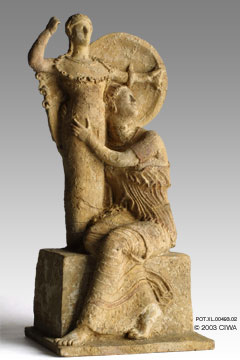
| Period: | | |
| Dating: | | 400 BC–323 BC |
| Origin: | | Greek World, Beotia |
| Material: | | Pottery (all types) |
| Physical: | | 24.5cm. (9.6 in.) - 575 g. (20.3 oz.) |
| Catalog: | | POT.XL.00493 |
Links to other views:
⇒ Larger View
if scripting is off, click the ⇒ instead.
• • •
Links to others of type Statuette-woman
Bronze female dancer, Rome, 200-27 BC
Bronze goddess Neith, Ptolemaic Period
Bronze of a queen nursing, Dyn. 25
Bronze of Ceres, Rome, 200 BC-307 AD
Bronze of Goddess Nebethetepet, Dyn. 12
Bronze of Mut, Ptolemaic Period
Bronze Venus, Alexandria, 50 BC-50 AD
Etruscan young woman, 570-550 BC
Gilded statue of a queen, Early Dynastic
Hathor as a woman, cow headed, N.K.
Protodynastic female statuette, Dyn. 0
Queen Aqaluqa as Isis nursing, Dyn. 25
Queen as Goddess Mut, Dyn.18
Queen as Isis nursing, Dyn. 12
Queen as Isis nursing, Dyn. 25
Queen as Isis-Hathor nursing, Dyn. 21
Queen Hatshepsut as Goddess Mut, Dyn. 18
Queen Hatshepsut as Hathor, Dyn. 18
Queen Isis as Isis nursing Thutmose III
Queen Isitnefret as Isis nursing, Dyn. 19
Queen Karama as Goddess Neith, Dyn. 22
Terracotta young woman, Greece, 450 BC
Woman and girl, Tanagra, 340-300 BC
Woman with elaborate headdress, Crete
|
|
This large terracotta statuette presents an allegorical scene in which Athena embraces Victory.
It probably came from Tanagra in the 4th century BC, or perhaps later, at the time of Alexander the Great (336-323 BC).
Bibliography (for this item)
Besques-Mollard, Simone
1950 Tanagra. Braun & Co., Paris, France. (5-9)
Cox, Warren
1945 The Book of Pottery and Porcelain. Crown Publishers, New York, NY. (60-62)
|